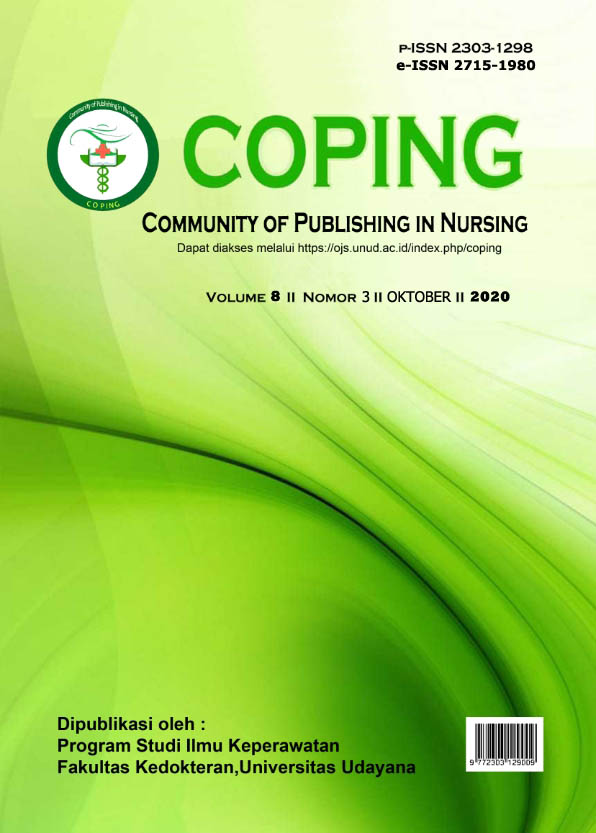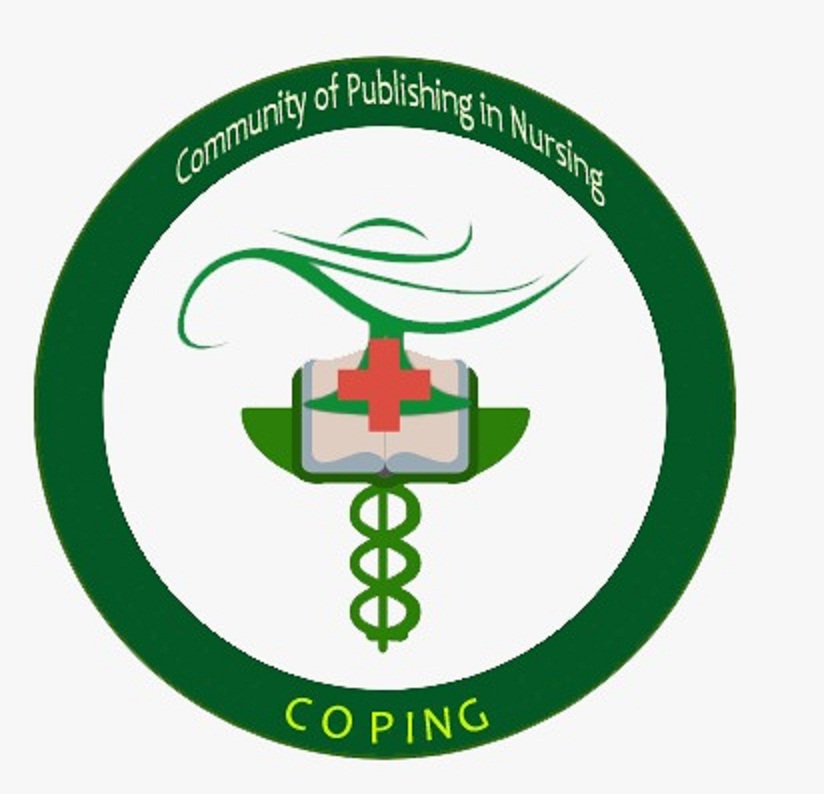HUBUNGAN ANTARA FREKUENSI KEMOTERAPI DAN STATUS NUTRISI PASIEN KANKER YANG MENJALANI KEMOTERAPI DI RUANG SANJIWANI RSUP SANGLAH DENPASAR
Abstract
Chemotherapy is an effective therapy for cancer management. Repeated chemotherapy can cause various side effects. Side effects that appear after chemotherapy may affect cancer patient’s nutrition status. This study aimed to determine the relationship between chemotherapy’s frequency and nutrition status on cancer patients who underwent chemotherapy in Sanjiwani Room at Sanglah General Hospital, Denpasar. The methods of this study is a retrospective study based on hospital information systems’s medical records. This study had purposive sampling technique and an 80 patients were chosen as sample. This study found that most of cancer patient had low category of chemotherapy’s frequency (1-3 cycle’s of chemotheraphy) (65%) and most of them had ideal nutrition status (BMI 18,5 – 25,0 kg/m2) (73.8%). Spearman Rank correlation test showed that there was a significant relationship between chemotherapy’s frequency and nutrition status on cancer patients who underwent chemotherapy in Sanjiwani Room at Sanglah General Hospital, Denpasar (p value = 0.00; ? = 0,05; r = -0.79). Determinant’s coeffisien’s (R) of this study known as 62,4%. In conclusion, there is strong negative’s correlation between chemotherapy’s frequency and nutrition status which means the more chemotherapy’s frequency makes nutrition status on cancer patients who underwent chemotherapy is less than ideal and vice versa. Most of chemotherapy frequency’s factor may affect patient’s nutrition status.
Downloads
References
Ang, A., Thomas, J., & Young, K. (2012). Nutritional risk of cancer patient who receping change of the ambulatory care setting : a prospective study. Singapore Nursing Journal. Diperoleh pada tanggal 6 November 2018 dari http:/eprints.qud.edu.au/81200/
Anggorowati, L. (2013). Faktor Risiko Kanker Payudara Wanita. Jurnal Kesehatan Masyarakat 8 (2): 121 – 126.
Astari, K. (2015) Hubungan Frekuensi Kemoterapi dan Kecemasan Terhadap Asupan Energi, Protein, Lemak dan Karbohidrat Pada Pasien Kanker Serviks Di RSUD Dr.Moewardi. Diperoleh pada tanggal 1 Juni 2019 dari http://eprints.ums.ac.id/37857/
Astika, N. (2017). Frekuensi Kemoterapi dapat Pengaruhi Asupan Zat Gizi dan Status Gizi pada Pasien Kanker Payudara di Ruang Perawatan Kelas III RSUP Sanglah Denpasar. Jurnal Skala Husada (14)1: 1 – 14.
Brunner & Suddarth. (2013). Buku Ajar Keperawatan Medikal Bedah Edisi 8 Vol. 2. Jakarta : EGC.
Caesandri, S.O.P., & Adiningsih, S. (2015). Peranan Dukungan Pendamping dan Kebiasaan Makan Pasien Kanker Selama Menjalani Terapi. Media Gizi Indonesia 10(2): 157 - 165
Choi, K. (2017). The Relationships among Chemotherapy-Induced Nausea and Vomiting (CINV), Non-Pharmacological Coping Methods, and Nutritional Status in Patients with Gynecologic Cancer. Journal of Korean Academy Nursing 47(6): 731 – 743.
Citra, W. (2012). Gambaran Efek Samping Kemoterapi Berbasis Antrasiklin pada Pasien Kanker Payudara di RSUD Dr. Soedarso Pontianak. Diperoleh pada tanggal 5 November 2018 dari jurnal.untan.ac.id/index.php/jfk/article/view/1769
Departemen Kesehatan RI. (2011). Pedoman Praktis Memantau Status Gizi Orang Dewasa. Diperoleh pada tanggal 24 Desember 2018 dari gizi.depkes.go.id/
Fadillah, D. (2017). Insidensi Penyakit Kanker di RSUP Dr. Wahidin Sudirohusodo Makassar Periode Januari 2015 - Juni 2017. Diperoleh pada tanggal 18 Desember 2018 dari digilib.unhas.ac.id
Farrell, C., Brearley, S. G., Pilling, M., & Molassiotis, A. (2012). The impact of chemotherapy-related nausea on patients’ nutritional status, psychological distress and quality of life. Supportive Care in Cancer 21(1): 59–66.
Fu, K. & Pan, H. (2017). Nutritional Status and Risk Factors for Malnutrition in CRC Patients Undergoing Neoadjuvant Therapy. Biomedical Research 28 (10): 4406-4412.
Halili, Y., Tat, F., & Letor, M.K. (2017). Hubungan Karakteristik dan Frekuensi Kemoterapi dengan Tingkat Gangguan Fisik (Alopesia, Nausea dan Vomit) pada Pasien Kanker yang Menjalani Kemoterapi di Ruangan Mutis RSUD Prof. Dr. W. Z. Johannes Kupang. CHMK Nursing Scientific Journal 1(2): 31 – 40.
Hardiano, R. (2015). Gambaran Indeks Massa Tubuh pada Pasien Kanker yang Menjalani Kemoterapi. JOM 2(2); 1381-1388.
Hariani, R. (2009). Kecukupan Nutrisi pada Pasien Kanker. Indonesian Journal of Cancer 4: 140 – 143.
Hariyanti, S. (2012). Faktor-Faktor yang Berhubungan dengan Status Gizi Penderita Kanker Payudara. Diperoleh pada tanggal 23 Juni 2019 dari lib.unnes.ac.id/698/
Hidayattulah, M.T. (2015). Profil Adverse Drug Reactions Cisplatin Regimen Kemoterapi pada Pasien Kanker Servik di RSUD Prof. Dr. Margono Soekardjo Purwokerto. Diperoleh pada tanggal 5 November 2018 dari http://repository.ump.ac.id/708/
Khairina, D. (2009). Faktor-faktor yang Berhubungan dengan Status Gizi Berdasarkan IMT pada Pembantu Rumah Tangga (PRT) Wanita di Perumahan Duta Indah Bekasi Tahun 2009. Diperoleh pada tanggal 23 Desember 2018 dari http://lib.ui.ac.id/file?file=digital/122525/
Komite Penanggulangan Kanker Nasional. (2015). Pedoman Kanker di Indonesia. Jakarta: Kemenkes.
Lalla, R.V., Bowen, J., Barasch, A., Elting, L., Epstein, J., Keefe, D.M. (2014). MASCC/ISOO clinical practice guidelines for the management of mucositis secondary to cancer therapy. Cancer 120(10): 1453–1461.
Melia, E.K.A., Putrayasa, I.D.P.Gd., Azis, A. (2013). Hubungan Frekuensi Kemoterapi terhadap Status Fungsional Pasien Kanker yang Menjalani Kemoterapi di RSUP Sanglah Denpasar. Diperoleh pada tanggal 5 November 2018 dari download.portalgaruda.org/article.php?article=80896&val=956
National Cancer Institute. (2009). Diarrhea and Cancer Treatment. Diperoleh pada tanggal 20 Januari 2019 dari www.cancer.gov/cancerinfo/
Notoadmodjo, S. (2010). Promosi Kesehatan dan Ilmu Perilaku. Jakarta: Rineka Cipta.
Noviyani, R. (2017). Efek Kemoterapi Bleomisin, Vincristin, Mitomisin dan Karboplatin terhadap Massa Tumor dan Infiltrasi Parametrium pada Pasien Kanker Serviks: Studi Kasus di RSUP Sanglah Denpasar. Jurnal Farmasi Klinik Indonesia 6(3); 164-170.
Nurhidayah, I., Sholehati, T., Nuraeni, A. (2013). Skor Mukositis pada Anak dengan Kanker yang Sedang Menjalani Kemoterapi di RSUP Dr. Hasan Sadikin Bandung. Jurnal Keperawatan Sudirman 8(1): 1 - 13
Priestman, T. (2012). Cancer Chemotherapy in Clinical Practice Second Edition. UK: Springer.
Pusat Informasi Obat Nasional. (2015). Farmakologika Keganasan dan Imunosupresif. Diperoleh pada tanggal 11 Januari 2019 dari http://pionas.pom.go.id
Putri, N. (2018). Hubungan Siklus Kemoterapi dengan Status Gizi Pasien Kanker Payudara di Ruang Rawat Inap Rumah Sakit Umum Daerah Dr. Zainoel Abidin Banda Aceh. Diperoleh pada tanggal 14 Februari 2019 dari etd.unsyiah.ac.id/36937
Rif’atunnia, S. (2017). Faktor Risiko terjadinya Mual Muntah Lambat akibat Kemoterapi pada Pasien Kanker Payudara. Jurnal Ilmiah Kesehatan Diagnosis 11(4): 388 – 392.
Riset Kesehatan Dasar. (2017). Prevalensi Kanker di Indonesia Tahun 2017. Jakarta: Kementerian Kesehatan RI.
Riset Kesehatan Dasar. (2018). Situasi Penyakit Kanker di Indonesia Tahun 2018. Jakarta: Kementerian Kesehatan RI.
Stein, A. (2010). Chemotherapy-induced diarrhea: pathophysiology, frequency and guideline-based management. Therapeutic Advances in Medical Oncology Journal 2(1): 51-63.
Suryapratama, S. A. (2012). Karakteristik Penderita Kanker Serviks di RSUD Dr. kariadi Semarang. Diperoleh pada tanggal 30 Mei 2019 dari http://eprints.ums.ac.id./14701/
Susanti, D. (2016). Pengaruh Terapi Relaksasi Autogenik terhadap Mual Muntah Post Kemoterapi pada Pasien Kanker Payudara di Rumah Sakit Islam Sultan Agung Semarang. Diperoleh pada tanggal 5 November 2018 dari http://repository.unissula.ac.id/10538/
Sutandyo, N. (2010). Nutrisi pada Pasien Kanker yang Mendapat Kemoterapi. Indonesian Journal of Cancer 4: 144 – 148.
Thamaria, N. (2017). Penilaian Status Gizi. Jakarta : Kementerian Kesehatan Republik Indonesia.
Unit Promosi Kesehatan RSUP Dr. Sardjito. (2015). Kemoterapi. Diperoleh pada tanggal 20 Desember 2018 dari www. sardjito.co.id
World Health Organization. (2018). National Cancer Control Programmes. Diperoleh pada tanggal 5 November 2018 dari http://www.who.int/cancer/en/







